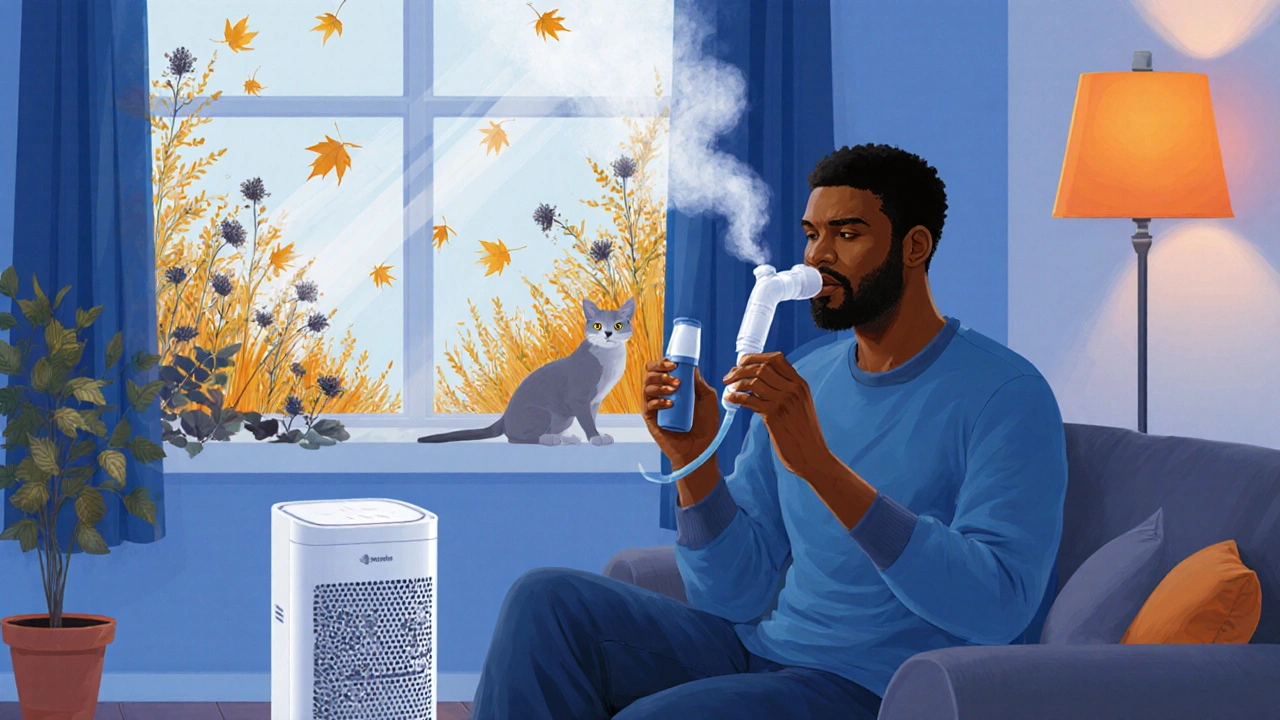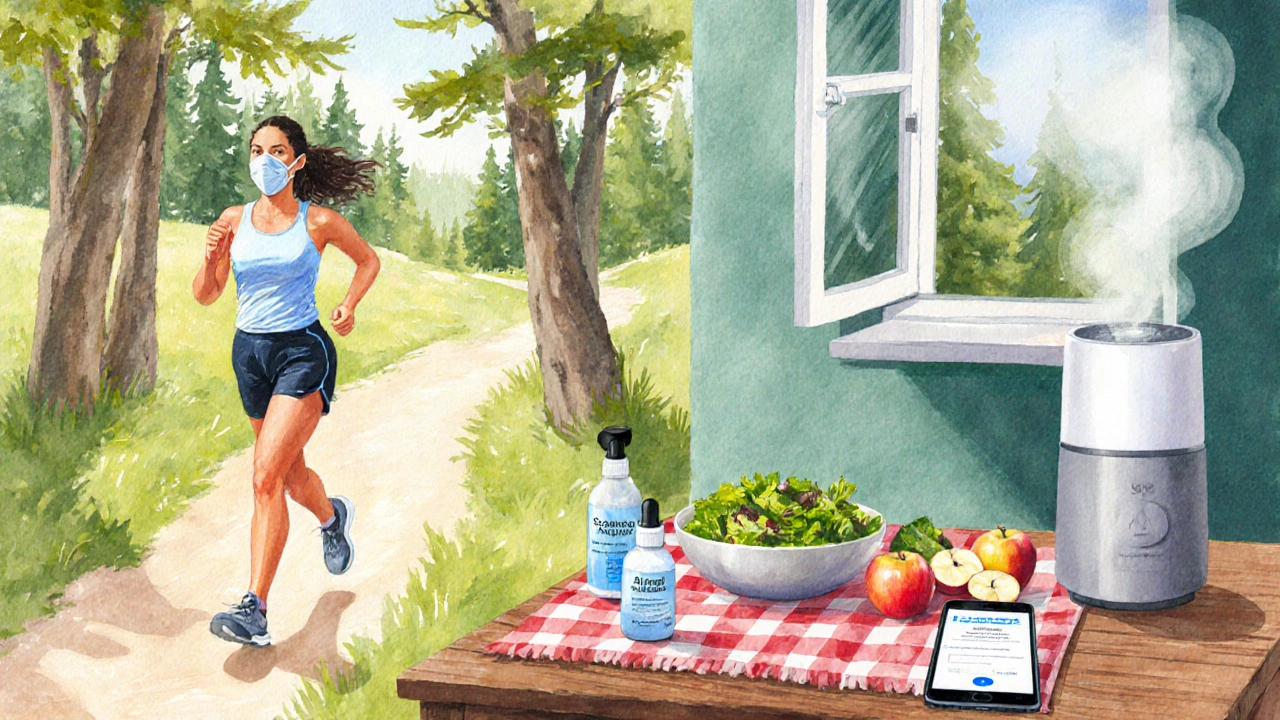
Answer the questions below to get personalized insights on how your emphysema and allergies might interact and what steps you can take to manage them better.
When Emphysema and allergies show up together, the breathing struggle can feel like a double‑whammy. One disease chips away at the lungs' structure, while the other triggers inflammation that narrows the airways. Knowing how these conditions intersect, what makes them worse, and which treatments actually help can turn a scary situation into a manageable one.
Emphysema is a chronic lung disease that destroys alveolar walls, reducing elastic recoil and causing air trapping. The damage is permanent, so the goal is to slow progression and keep symptoms in check. Emphysema is a major component of chronic obstructive pulmonary disease (COPD), which also includes chronic bronchitis.
Allergy is an immune system overreaction to otherwise harmless substances such as pollen, dust mites, or pet dander. When an allergen contacts the respiratory tract, mast cells release histamine, leading to swelling, mucus, and bronchoconstriction. While many think of allergies as seasonal, they can be present year‑round and often coexist with other lung conditions.
Both conditions affect airflow, but they do it in different ways. Emphysema reduces the lung’s capacity to push air out, while allergies cause the muscles around the airways to tighten and the lining to swell. When a person with emphysema experiences an allergic flare‑up, the already compromised breathing becomes even harder.
Research from a 2023 European Respiratory Journal cohort of 2,500 patients found that those with both emphysema and allergic rhinitis reported 30% more emergency visits than those with emphysema alone. The synergy isn’t just anecdotal; it’s backed by data.

Getting a clear picture starts with a thorough medical history and physical exam. Doctors then move to objective tests:
When results show both airflow obstruction and a positive allergy test, the treatment plan must address both sides.
There’s no single pill that fixes everything, but a layered approach works well.
For emphysema, quitting smoking is the single most effective step. Nicotine replacement, prescription varenicline, or bupropion can double success rates. Pair this with air‑filter use at home and masks during high‑pollution days.
Exercise training, breathing techniques, and education improve stamina. Studies from the UK’s National Health Service show a 15% reduction in hospital admissions for patients who complete a 12‑week program, even when they have co‑existing allergies.
Flu and pneumococcal shots prevent infections that could trigger severe exacerbations. Allergic patients who receive regular influenza vaccines experience fewer missed workdays.
If you notice any of these signs, call emergency services:
Rapid intervention with oxygen and systemic steroids can save lung tissue from permanent damage.
| Feature | Emphysema (COPD component) | Allergy‑Driven Disease (e.g., allergic asthma, rhinitis) |
|---|---|---|
| Primary Pathology | Destruction of alveolar walls, loss of elastic recoil | Immune‑mediated inflammation, bronchial smooth‑muscle constriction |
| Typical Triggers | Long‑term smoking, occupational dust, air pollutants | Pollen, dust mites, animal dander, mold spores |
| Diagnostic Test Highlights | Reduced FEV1/FVC, hyperinflated lungs on CT | Positive skin prick or specific IgE, reversible airway obstruction |
| Key Medications | Bronchodilators, inhaled corticosteroids (if eosinophilic), phosphodiesterase‑4 inhibitors | Antihistamines, leukotriene antagonists, allergen immunotherapy |
| Long‑Term Outlook | Gradual decline, can be slowed with smoking cessation | Often controllable; symptoms may lessen with immunotherapy |

Allergies themselves do not destroy alveolar tissue, so they don’t directly cause emphysema. However, repeated allergic inflammation can worsen airflow limitation, making existing emphysema symptoms feel more severe.
Yes, when prescribed at the right dose. Inhaled corticosteroids reduce allergic inflammation and can lower the risk of COPD exacerbations in patients with elevated eosinophil counts. Monitoring for oral thrush is still important.
Often a single combination inhaler (LABA+ICS) covers both needs. For sudden allergy spikes, a short‑acting bronchodilator is kept on hand as a rescue device.
Most people notice a reduction in seasonal symptoms after 6‑12 months of consistent treatment. The benefit is gradual but can meaningfully lessen the need for rescue inhalers over time.
Yes. Quitting smoking, using air purifiers, staying active through low‑impact exercises, and maintaining a healthy weight all support lung function and reduce allergic inflammation.
When the lungs are already compromised by emphysema, an allergic flare can feel like an unexpected storm crashing into a fragile house; the airways tighten, mucus spikes, and breathlessness skyrockets. The synergy between alveolar destruction and histamine‑driven inflammation explains why patients often report a sudden drop in oxygen levels during pollen season. It’s crucial to keep an eye on environmental triggers and to coordinate bronchodilator use with antihistamines to blunt the double impact.
Have you considered a combined inhaler that delivers both a LABA and an inhaled corticosteroid? Many clinicians find that such regimens can simplify dosing and improve adherence, especially when allergies flare.
Finally, tracking symptoms in a daily journal can reveal patterns that guide your doctor toward personalized immunotherapy or adjusted dosing.
Sounds solid just stick to the plan and keep those windows shut
Living with both emphysema and allergies creates a continuous balancing act that can feel like walking a tightrope over a sea of smoke 🌫️. Each breath becomes a negotiation between the structural loss of alveoli and the sudden surge of histamine that narrows the airways. The body’s response to pollen or dust mites can trigger bronchospasm, which, on top of existing air‑trapping, leads to an alarming sense of suffocation. Because the two conditions amplify each other, medication timing is paramount; a rescue inhaler should be within arm’s reach before an allergic episode escalates 🚀.
Long‑acting bronchodilators keep the baseline airway tone relaxed, while inhaled corticosteroids dampen the chronic inflammation that allergic triggers provoke. Adding a leukotriene receptor antagonist can further smooth out the response to seasonal allergens, especially when asthma‑type symptoms overlap.
Air quality monitors at home help you spot spikes in PM2.5 or ozone, giving you the chance to activate air purifiers or don a mask before exposure becomes harmful 🏠. HEPA filters capture pollen and dust mites, reducing the antigen load that would otherwise inflame the respiratory tract.
Immunotherapy, whether via sublingual tablets or allergy shots, gradually re‑educates the immune system. Although the benefits appear after six to twelve months, many patients report a marked reduction in rescue inhaler use once tolerance builds.
Smoking cessation is non‑negotiable; even occasional exposure can undo the gains from other therapies. Pharmacologic aids like varenicline or bupropion can raise the odds of quitting, and combining them with behavioral counseling yields the best outcomes 🚭.
Vaccinations against influenza and pneumococcus are simple yet powerful tools to prevent infections that could tip the balance toward a severe exacerbation. A single flu season can mean weeks of additional breathlessness if not avoided.
Regular pulmonary rehabilitation sessions strengthen the respiratory muscles, improve exercise tolerance, and teach breathing techniques such as pursed‑lip breathing, which is especially useful during an allergic flare.
Hydration keeps mucus thin and easier to clear, while a balanced diet rich in antioxidants supports overall lung health.
Keeping a symptom diary that logs pollen counts, air quality indices, and medication use provides invaluable data for your clinician to fine‑tune the treatment plan.
In summary, the key is a layered strategy: quit smoking, control the environment, synchronize medications, and consider long‑term immunotherapy. With diligence, the double‑whammy of emphysema and allergies can be tamed, allowing you to breathe easier and enjoy daily activities 😊.
The interplay of damaged alveoli and allergic inflammation creates a tapestry of breathlessness that is both fragile and fierce. Harnessing air‑purifiers and strict allergen avoidance can stitch up the weakest threads of that tapestry. Pairing a LABA‑ICS inhaler with antihistamines often weaves a smoother breathing pattern. Ultimately, a journal acts as a compass, guiding you through the fog of symptoms toward clearer skies.
It is worth noting that regular spirometry can quantify the degree of obstruction contributed by emphysema, while skin‑prick testing isolates the allergic components. Aligning these diagnostic results enables a targeted therapeutic plan that addresses both airway collapse and immune‑mediated inflammation. Moreover, occupational exposure histories often reveal hidden irritants that exacerbate both conditions, so a thorough review is essential.
Great point about the occupational history it often gets missed and patients may not think to mention it especially if they think it’s unrelated
Keeping a simple checklist of triggers and meds works really well 👍. Carry your rescue inhaler and keep windows shut when pollen is high 🌸. A quick daily note on how you feel can help the doctor make better choices 😊.
In the theater of breath, each inhalation is a whispered promise, each exhalation a fleeting surrender. When allergy storms clash with the hollowed chambers of emphysema, the drama reaches its climax, demanding both courage and cunning. Embrace the ritual of medication as a solemn pact, and let the steadfast rhythm of pulmonary rehab be your metronome.
Stop ignoring the pollen it’s makin ur lungs hurt enough already get a purifier and quit smoking now
Indeed the omission of adequate air filtration undermines therapeutic efforts and perpetuates inflammatory cycles it would be prudent to adopt HEPA systems alongside cessation programmes for optimal outcomes